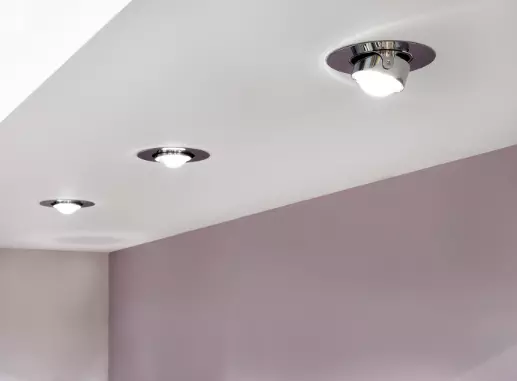Most ceiling lights can be mounted on the walls. Only heavy layered glass ceiling lights such as duplex are not recommended for wall mounting.
It is important to position the lamp holder at the bottom of the product when mounting a ceiling light on the wall to make the heat that will be generated rise away from the lamp holder.
How to Mount Ceiling Lights on the Walls?
- Switch off any power supply before installing your light. Use an electric tester to make sure that there is no active power supply.
- Install the lamp holder on the wall. Use screw plugs to screw the lamp holder tightly against the wall.
- Connect the wires to the wall lamb. Make sure that there is an available connection in the area where you want to mount the wall lamp. There are usually two wires, a black one and a yellow one. An extra one that is yellow-green too is found on earthed wall lamps. Strip the plastic off the wire a little bit. Most connectors have two main openings and an extra one for the earthed wire where you insert the wires through. Screw the connector block tightly and ensure that there is no loose wire.
- Attach the wall lamp to the lamp holder. Raise the light to the mounting bracket that is attached to the wall.
- Insert the light bulb when you are done installing the wall lamp and turn the power back on. No light usually comes with a wall lamp and it is up to you to find the appropriate one.
Can you put Wall Lights on a Ceiling?
Wall lights can be installed on ceilings. To install a wall light on a ceiling you will need a ceiling box and wire.

Even if the box is not level you can level the feature because most sconces mount with a center stud.
Wall lights placed on ceilings should be at least 5.5 eat above the ground.
When installing more than one, they should be more than 7 feet apart.
To avoid glare from the exposed bulb, aim for the top of the wall light to sit at eye level.
To install the light on the ceiling
- Locate where you will place the light, and use the ceiling box to drill holes in the ceiling.
- Install cables from the power source through the ceiling box and nail it to the side of the ceiling.
- Connect wires from the cable with wires to the fixture. Black, white, and bare copper wires should be connected.
- Attach the lighting fixture to the ceiling box with the manufacturer’s provided mounting.
- Can ceiling lights be moved?
- Ceiling light features can be moved to new locations.
How to Move Ceiling Lights?
- Switch off the power from the main switch.
- Unscrew the light bulbs from the mixture.
- Lower the canopy from the ceiling after unscrewing it.
- Remove the wiring from the ceiling. On the end of the joined wires loosen and remove the plastic wire nuts. The bare ends of the wire should not meet. Check the wiring from a voltage tester. Always call an electrician when you feel you can’t do it on your own.
- The black wire from the fixture should be separated from the black wire from the electrical cable. Separate the ground wires and the white wires too.
- Lower the lighting fixture slowly after detaching it from the electrical box. Unscrew the electrical box and remove it from the ceiling
- Locate a ceiling joist where you want to locate your light fixture. A new electric box should be placed against the ceiling next to the joist to trace the box onto the ceiling.
- Use a dry saw to cut a hole in the ceiling that follows the traced outline.
- Connect the wires from the new cable to the wires of the old electric cable.
- On the new electric box punch the knockout hole, slide the cable through it, place the box to the ceiling, and screw it.
- Connect the wires of the lighting fixture to the wires inside the cables by matching the colors
- On the electrical box, attach the light fixture.
- The wiring should be placed on the electrical box and the canopy screwed into place against the ceiling.
- On the space where the light feature was originally located, patch the hole.
Do Ceiling Lights Need to be Earthed?

Ceiling lights should be earthed to keep you protected from the risk of electrocution and serious injury.
When your bulb holders and lights lack earthed wires, it is because it is not necessary.
After all, the material mostly used to make them is glass, ceramic, or plastic.
Unearthed cables and units you are using should be timed back safely using electrical insulation tape.
To earth ceiling lights:
- Strip all three wires available a little bit.
- Use the earthed wire to connect the grounding screw to the grounding bar
- Wrap the wire caps with tape or protection.
Do Ceiling Lights Have to Match?
Ceiling lights in the same room need to be matched. It is the right decision to be consistent across your rooms.

Your dining area and living room should have matching lights.
The overall feel of the rooms should flow well together.
Not matching lights in these areas and the kitchen too which is always near these areas in most traditional houses can confuse the spaces.
Trying to mix lights in a single room can make you uncomfortable and confused. To match ceiling lights in your room:
Layer Your Type of Light
This is always the foundation of a well-lit place. Layers help improve versatility, set unction, and illuminate any space. Each type of light you choose should be according to the reasons why you want to include it in your lighting design.
Create Focal Points and don’t distract them
focal points can be light fixtures, unique lamps, and stunning chandeliers but they mustn’t have to be. Any point in the room that lighting draws attention to can be your focal point. These can include a fireplace mantel or artwork. Wall scones and track lighting can complement whatever you want to be the center of attention.
Coordinate across Rooms in an open-look
These rooms including living rooms, kitchens, and dining rooms need to have matching lights. The lighting in these rooms needs to be consistent. The feel of the rooms should always flow together even though they don’t necessarily match.
Should Lighting Fixtures Match throughout the House?
Lighting fixtures do not have to match throughout the house. You can express your preferences in the interior lighting of the house.
The lighting around your house rooms can match, complement each other, or have an eclectic look. Check out our comprehensive guide on the best ceiling lights for your living room to know the best options that can match your house,
Matching
I can install matching light fixtures for your home if you like your home rooms to contain a cohesive design style. Elegant lights can be perfect or traditional decorated houses.
Complementary
Lighting fixtures that complement each other and don’t necessarily match can add a different color scheme and a slight variance in style in your house’s direct rooms. You can choose complementing lights in your kitchen, dining, living room, and other different rooms in your house.
Eclectic Decorating
Matching all the lighting fixtures in all your house’s rooms is never appealing to people who like an eclectic look. It is not a crime to have completely different lights in all rooms of your house. You can install a new light in your room that you saw at an exotic place you traveled to.

As a homeowner, I am specifically keen on home improvement. I am passionate about homes, yards, and home improvement. I blog on home ideas and reviews on solutions that make homes better.